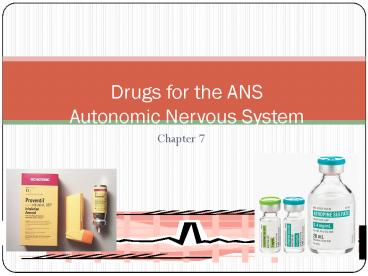Drugs for the ANS Autonomic Nervous System - PowerPoint PPT Presentation
1 / 17
Title:
Drugs for the ANS Autonomic Nervous System
Description:
Sympathomimetics or adrenergic agonists stimulate sympathetic nervous system ... All 4 types of adrenergic receptors heart and airways epinephrine ... – PowerPoint PPT presentation
Number of Views:423
Avg rating:5.0/5.0
Title: Drugs for the ANS Autonomic Nervous System
1
Drugs for the ANSAutonomic Nervous System
- Chapter 7
2
Introduction
- Neuropharmacology represents one of the largest,
most complicated, and least understood branches
of pharmacology. - Nervous system medications are used to treat a
large and diverse set of conditions, including
pain, anxiety, depression, schizophrenia,
insomnia, and convulsions.
3
Introduction
- Through their effects on nerves, medications are
also used to treat many disorders that are
considered diseases of other organ systems. - Examples include abnormalities in heart rate and
rhythm, high and low BP, pressure within the
eyeball, asthma, and even a runny nose.
4
Peripheral Nervous System
- The peripheral nervous system is divided into
somatic and autonomic components - Nervous systemtwo major divisions
- 1. Central nervous system (CNS)brain and spinal
cord. - 2. Peripheral nervous system (PNS)nervous
tissue outside the CNS
5
Nervous System
- Basic Functions of the nervous system
- Recognize changes in the internal and external
environments - Process and integrate the environmental changes
that are perceived - React to the environmental changes by producing
an action or response
6
Peripheral Nervous System
- Peripheral nervous system
- Sensory and motor functions
- Somatic nervous systemcontrol skeletal muscles
(voluntary) - Autonomic nervous systemcontrols smooth muscle,
cardiac muscle and glands (involuntary)
7
Autonomic Nervous System
- The autonomic Nervous system has sympathetic and
parasympathetic branches. - Most organs and glands have nerves from both
branches.
8
Autonomic Nervous System
- Sympathetic Nervous system
- Functionactivated under conditions of stress
- Fight-or-flight--
- Parasympathetic nervous system
- Functionactivated under non-stressful conditions
- Rest and relax
9
Autonomic Drugs
- Autonomic drugs classified by which receptors
they stimulate or block - Sympathomimetics or adrenergic agonists stimulate
sympathetic nervous systemproduce the classic
symptoms of the fight-or-flight response. - Parasympathomimetics or cholinergic agonist
stimulate parasympathetic nervous system and
produce the classic symptoms of the
rest-and-relaxation response.
10
Autonomic Drugs
- Adrenergic blockers inhibit sympathetic nervous
division which is the opposite action of
sympathomimetics. - Anticholinergic or cholinergic blockers inhibit
parasympathetic nervous system which is the
opposite action of parasympathomimetics
11
Parasympathomimetics
- Table 7.3 pg. 92.
- Few therapeutic uses because of numerous side
effects. - Include organic phosphate insecticides and toxic
nerve gases - Some useful for effects on acetylcholine receptor
in skeletal muscles and CNS. - Drug profilel (Urecholine) pg. 93
- Helps in Urination
12
Anticholinergics
- Table 7.4 pg. 95
- Also called Muscarinic blockers.
- Most therapeutic uses of the anticholinergics are
predictable extension of their autonomic actions
dilation of the pupil, increase in heart rate,
drying of secretions, and dilation of the
bronchi.
13
Anticholinergics
- Many side effectstachycardia and urinary
retention. - Replaced with safer and more effective drugs
- Some used for effects on CNS
- Scopolamine (Hyoscine)sedation and motion
sickness - Benztropine (Cogentin)Parkinsons disease
- Drug profileatropine pg. 95
14
Sympathomimetics
- Table 7.5 pg. 98.
- Stimulate alpha an/or beta receptors
- Selectivestimulate only one type of adrenergic
receptor - 1. Alpha 1nasal mucous membrane decrease
secretions phenylphrine (neo-Synephrine)
15
Sympathomimetics
- 2. Alpha 1blood vessels relax smooth muscle
clonidine (Catapress) - 3. Beta 1heart increase heart rate and force
of contraction dobutamine (Dobutrex) - 4. Beta 2airways relax smooth muscle
albuteron (proventil)
16
Sympathomimetics
- NonselectiveStimulate more than one adrenergic
receptor - All 4 types of adrenergic receptorsheart and
airwaysepinephrine - Alpha 1 and beta2nasal mucous membrane and
heart pseudephrine (Sudafed) - Beta 1 and beta 2heart and airways
isoproterenol (Isuprel)
17
Adrenergic Blockers
- Most widely prescribed autonomic drugs for
hypertension. - They may be selective for only one receptor
subtype, such as the beta1-blockers,or inhibit
several subtypes. - HTN is their primary indication.































